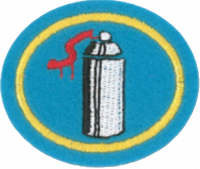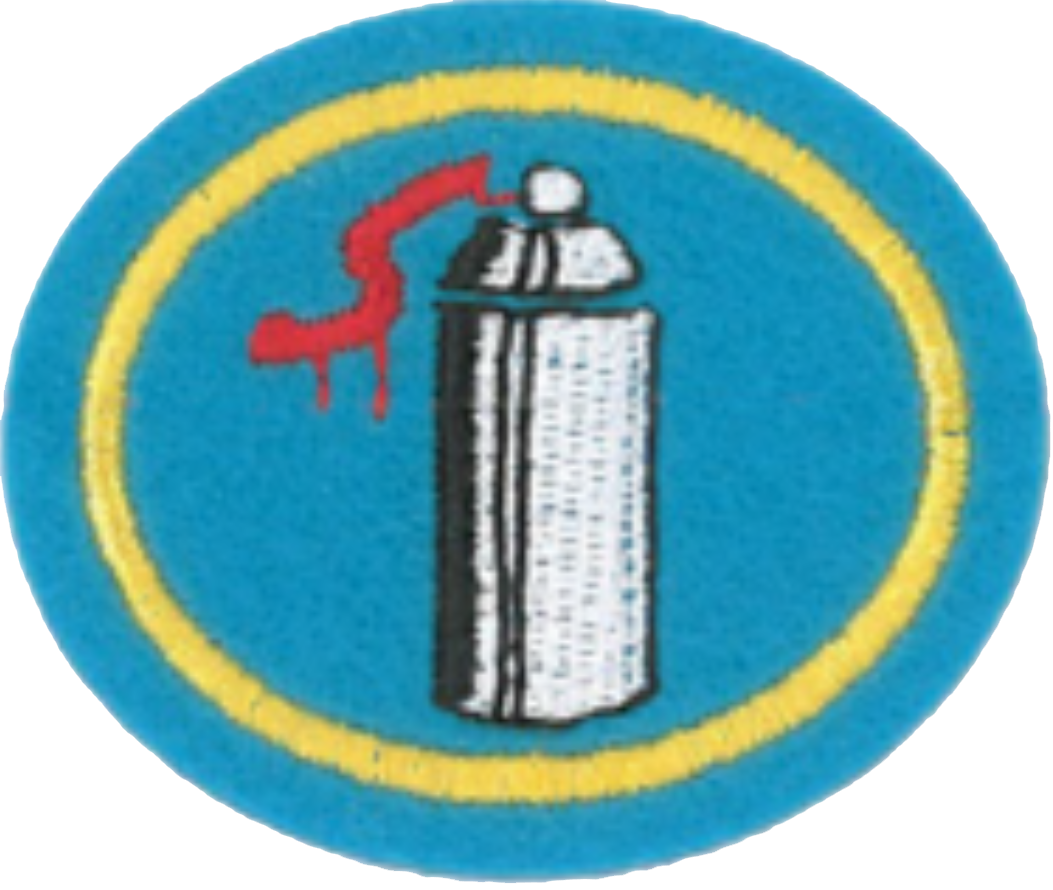Difference between revisions of "AY Honors/Street Art/Answer Key/es"
(Created page with "Especialidades JA/Arte callejero/Respuestas") |
(Created page with "</noinclude> <!-- 5. Definir los siguientes términos: -->") |
||
| Line 8: | Line 8: | ||
{{CloseReq}} <!-- 1 --> | {{CloseReq}} <!-- 1 --> | ||
{{ansreq|page={{#titleparts:{{PAGENAME}}|2|1}}|num=2}} | {{ansreq|page={{#titleparts:{{PAGENAME}}|2|1}}|num=2}} | ||
| − | <noinclude> | + | <noinclude></noinclude> |
| − | </noinclude> | + | <!-- 2. Resumir lo que Dios «pintó» en los seis días de la Creación y lo que hizo el séptimo día. --> |
| − | <!-- 2. | + | Dios «pintó» este mundo y «etiquetó» su nombre al finalizar su pintura con su «etiqueta» en el séptimo día (Génesis 1-2). |
| − | |||
| − | |||
| − | + | <noinclude></noinclude> | |
| − | <noinclude | ||
| − | |||
{{CloseReq}} <!-- 2 --> | {{CloseReq}} <!-- 2 --> | ||
{{ansreq|page={{#titleparts:{{PAGENAME}}|2|1}}|num=3}} | {{ansreq|page={{#titleparts:{{PAGENAME}}|2|1}}|num=3}} | ||
| − | <noinclude> | + | <noinclude></noinclude> |
| − | </noinclude> | + | <!-- 3. Explicar la historia del grafiti dentro de la cultura Hip Hop. --> |
| − | <!-- 3. | ||
| − | |||
| − | |||
| − | + | {{clear}} | |
| − | |||
| − | |||
| − | + | {{clear}} | |
| − | |||
| − | |||
<div lang="en" dir="ltr" class="mw-content-ltr"> | <div lang="en" dir="ltr" class="mw-content-ltr"> | ||
| Line 41: | Line 30: | ||
</div> | </div> | ||
| − | + | <noinclude></noinclude> | |
| − | <noinclude | ||
| − | |||
{{CloseReq}} <!-- 3 --> | {{CloseReq}} <!-- 3 --> | ||
{{ansreq|page={{#titleparts:{{PAGENAME}}|2|1}}|num=4}} | {{ansreq|page={{#titleparts:{{PAGENAME}}|2|1}}|num=4}} | ||
| − | <noinclude> | + | <noinclude></noinclude> |
| − | </noinclude> | + | <!-- 4. ¿Cuáles son los tres hechos del grafiti? --> |
| − | <!-- 4. | ||
| − | |||
| − | |||
| − | |||
| − | |||
| − | |||
| − | |||
| − | |||
| − | |||
| − | |||
| − | + | <noinclude></noinclude> | |
| − | <noinclude | ||
| − | |||
{{CloseReq}} <!-- 4 --> | {{CloseReq}} <!-- 4 --> | ||
{{ansreq|page={{#titleparts:{{PAGENAME}}|2|1}}|num=5}} | {{ansreq|page={{#titleparts:{{PAGENAME}}|2|1}}|num=5}} | ||
| − | <noinclude> | + | <noinclude></noinclude> |
| − | </noinclude> | + | <!-- 5. Definir los siguientes términos: --> |
| − | <!-- 5. | ||
| − | |||
| − | + | <noinclude></noinclude> | |
| − | <noinclude | ||
| − | |||
{{ansreq|page={{#titleparts:{{PAGENAME}}|2|1}}|num=5a}} <!--T:12--> | {{ansreq|page={{#titleparts:{{PAGENAME}}|2|1}}|num=5a}} <!--T:12--> | ||
| − | <noinclude> | + | <noinclude></noinclude> |
| − | </noinclude | ||
| − | |||
| − | |||
| − | + | <noinclude></noinclude> | |
| − | <noinclude | ||
| − | |||
{{CloseReq}} <!-- 5a --> | {{CloseReq}} <!-- 5a --> | ||
{{ansreq|page={{#titleparts:{{PAGENAME}}|2|1}}|num=5b}} <!--T:13--> | {{ansreq|page={{#titleparts:{{PAGENAME}}|2|1}}|num=5b}} <!--T:13--> | ||
| − | <noinclude> | + | <noinclude></noinclude> |
| − | </noinclude | ||
| − | |||
| − | |||
| − | + | <noinclude></noinclude> | |
| − | <noinclude | ||
| − | |||
{{CloseReq}} <!-- 5b --> | {{CloseReq}} <!-- 5b --> | ||
{{ansreq|page={{#titleparts:{{PAGENAME}}|2|1}}|num=5c}} <!--T:14--> | {{ansreq|page={{#titleparts:{{PAGENAME}}|2|1}}|num=5c}} <!--T:14--> | ||
| − | <noinclude> | + | <noinclude></noinclude> |
| − | </noinclude | ||
| − | |||
| − | |||
| − | + | <noinclude></noinclude> | |
| − | <noinclude | ||
| − | |||
{{CloseReq}} <!-- 5c --> | {{CloseReq}} <!-- 5c --> | ||
{{ansreq|page={{#titleparts:{{PAGENAME}}|2|1}}|num=5d}} <!--T:15--> | {{ansreq|page={{#titleparts:{{PAGENAME}}|2|1}}|num=5d}} <!--T:15--> | ||
| − | <noinclude> | + | <noinclude></noinclude> |
| − | </noinclude | ||
| − | |||
| − | |||
| − | + | <noinclude></noinclude> | |
| − | <noinclude | ||
| − | |||
{{CloseReq}} <!-- 5d --> | {{CloseReq}} <!-- 5d --> | ||
{{ansreq|page={{#titleparts:{{PAGENAME}}|2|1}}|num=5e}} <!--T:16--> | {{ansreq|page={{#titleparts:{{PAGENAME}}|2|1}}|num=5e}} <!--T:16--> | ||
| − | <noinclude> | + | <noinclude></noinclude> |
| − | </noinclude | ||
| − | |||
| − | |||
| − | + | <noinclude></noinclude> | |
| − | <noinclude | ||
| − | |||
{{CloseReq}} <!-- 5e --> | {{CloseReq}} <!-- 5e --> | ||
{{ansreq|page={{#titleparts:{{PAGENAME}}|2|1}}|num=5f}} <!--T:17--> | {{ansreq|page={{#titleparts:{{PAGENAME}}|2|1}}|num=5f}} <!--T:17--> | ||
| − | <noinclude> | + | <noinclude></noinclude> |
| − | </noinclude | ||
| − | |||
| − | |||
| − | + | <noinclude></noinclude> | |
| − | <noinclude | ||
| − | |||
{{CloseReq}} <!-- 5f --> | {{CloseReq}} <!-- 5f --> | ||
{{ansreq|page={{#titleparts:{{PAGENAME}}|2|1}}|num=5g}} <!--T:18--> | {{ansreq|page={{#titleparts:{{PAGENAME}}|2|1}}|num=5g}} <!--T:18--> | ||
| − | <noinclude> | + | <noinclude></noinclude> |
| − | </noinclude | ||
| − | |||
| − | |||
| − | + | <noinclude></noinclude> | |
| − | <noinclude | ||
| − | |||
{{CloseReq}} <!-- 5g --> | {{CloseReq}} <!-- 5g --> | ||
{{ansreq|page={{#titleparts:{{PAGENAME}}|2|1}}|num=5h}} <!--T:19--> | {{ansreq|page={{#titleparts:{{PAGENAME}}|2|1}}|num=5h}} <!--T:19--> | ||
| − | <noinclude> | + | <noinclude></noinclude> |
| − | </noinclude | ||
| − | |||
| − | |||
| − | + | <noinclude></noinclude> | |
| − | <noinclude | ||
| − | |||
{{CloseReq}} <!-- 5h --> | {{CloseReq}} <!-- 5h --> | ||
{{ansreq|page={{#titleparts:{{PAGENAME}}|2|1}}|num=5i}} <!--T:20--> | {{ansreq|page={{#titleparts:{{PAGENAME}}|2|1}}|num=5i}} <!--T:20--> | ||
| − | <noinclude> | + | <noinclude></noinclude> |
| − | </noinclude | ||
| − | |||
| − | |||
| − | + | <noinclude></noinclude> | |
| − | <noinclude | ||
| − | |||
{{CloseReq}} <!-- 5i --> | {{CloseReq}} <!-- 5i --> | ||
{{ansreq|page={{#titleparts:{{PAGENAME}}|2|1}}|num=5j}} <!--T:21--> | {{ansreq|page={{#titleparts:{{PAGENAME}}|2|1}}|num=5j}} <!--T:21--> | ||
Revision as of 20:52, 3 May 2021
Nivel de destreza
2
Año
2020
Version
11.11.2025
Autoridad de aprobación
División Norteamericana
1
2
Dios «pintó» este mundo y «etiquetó» su nombre al finalizar su pintura con su «etiqueta» en el séptimo día (Génesis 1-2).
3
Graffiti art is a uniquely American art form. Today, it is influencing the work of creative individuals worldwide in areas as diverse as graphic design, photography, advertising, marketing, illustration, fine art, and even multimedia and technology.
Why are we attracted to graffiti? Part of it has to do with the psychology of affirmation. There is something inside of us that wants to take up space and proclaim our existence. We want to be famous, seen, recognized, acknowledged, and affirmed. Graffiti can do that. It has always been about rebellion, style, observation, and self-worth. Unfortunately, these descriptions are fed by negative actions.
4
5
5a
5b
5c
5d
5e
5f
5g
5h
5i
5j
The nozzle for the aerosol paint can, also referred to as “tips”; different kinds are used for different styles
5k
A group of associated graffitists that often work together; crews are differentiated from gangs in that their main objective is to paint graffiti
5l
To remove painted graffiti with chemicals and other instruments, or to paint over it with a flat color
5m
Graffiti with text so stylized as to be difficult to read; often with interlocking three-dimensional type
5n
To bomb or hit is to paint over many surfaces in an area
5o
A legalized form of artistic vandalism, where the artwork often depicts a message
6
6a
6b
6c
6d
6e
6f
6g
6h
6i
6j
6k
6l
7
7a
Doodling: graffiti that we all did/do on our desk growing up in school Latrinalia: graffiti we see at rest stops or gas station restrooms
7b
Gang graffiti:graffiti written in public areas by local gangs; purpose of this is to mark territory and cause terror in the community Tags: quick and stylish signatures of the individual person Throw ups: a throw-up or “throwie” generally consists of a one-color outline and one layer of fill-color. Easy-to-paint bubble shapes often for letters. A throw-up is designed for quick execution, to avoid attracting attention to the writer. Throw-ups are often utilized by writers who wish to achieve a large number of tags while competing with rival graffitists. Most graffitists have both a tag and a throw-up that are essentially fixed compared to pieces. It is mostly so because they need to have a recognizable logo for others to identify them and their own individual style. Walls/pieces: a large, complex, and labor-intensive graffiti painting consisting of letters. Pieces often incorporate 3D effects, and many colors and color transitions, as well as various other effects. These will usually be done by writers with more experience. A piece requires more time to paint than a throw-up. If placed in a difficult location and well executed, it will earn the writer more respect. Piece can also be used as a verb that means “to write.” Murals/street art: a large picture painted or affixed directly on a wall or ceiling
8
Street art adorns the landscape; graffiti tagging scars it and accelerates urban decay Street art stretches your mind; graffiti closes it Street art is about the audience; graffiti is about the tagger/writer Street art says “have you thought about this?”; graffiti says “I tag, therefore I exist” Street art is done with a smile; graffiti is done with a scowl Street art takes skill; graffiti takes guts Street art delivers a message; graffiti delivers a mess We mourn losing street art and celebrate losing graffiti tagging.
Influence: Kids ages 13-18 are more sensitive to graffiti Teens living in the city Described as “taggers,” “writers,” “bombers” Cry for attention It is an adrenaline rush It is about respect This rebellious attitude against society is often manifested in their defiance against authority Media and subculture have a strong role
9
9a
9b
9c
9d
10
10a
10b
Practice, practice, practice
Note: Always spray by strokes (have a 1, 2.1, 2.1, 2 count), not a consistent spray. This prevents overspray and drips.
10c
10d
10e
11
Note: Always draw out your first initial drawing with a very light color then do the final drawing with a slightly darker color. Similar to how one would first draw with a pencil and follow it with a pen.
12
But you are a chosen generation, a royal priesthood, a holy nation, His own special people, that you may proclaim the praises of Him who called you out of darkness into His marvelous light;
Let every soul be subject to the governing authorities. For there is no authority except from God, and the authorities that exist are appointed by God.
13


